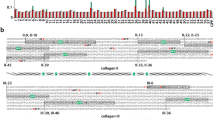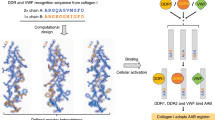Abstract
In rheumatoid and osteoarthritis, degradation of articular cartilage is mediated by the matrix metalloproteinases collagenase, stromelysin and gelatinase. The key event in this process is the cleavage of triple helical collagen by collagenase. We have determined the crystal structure of the catalytic domain of human recombinant fibroblast collagenase complexed with a synthetic inhibitor at 2.2 Å resolution. The protein fold is similar to the amino termini of the zinc endopeptidases astacin thermolysin and elastase despite a lack of primary sequence homology. The conformation of the bound inhibitor provides a molecular basis for the design of inhibitors of collagenase and other matrix metalloproteinases. Such inhibitors should be useful in the treatment of a variety of diseases including arthritis and cancer.
This is a preview of subscription content, access via your institution
Access options
Subscribe to this journal
Receive 12 print issues and online access
$189.00 per year
only $15.75 per issue
Buy this article
- Purchase on Springer Link
- Instant access to full article PDF
Prices may be subject to local taxes which are calculated during checkout
Similar content being viewed by others
References
Hardingham, T.E., Fosang, A.J. & Dudhia, J. Aggrecan — the chondroitin sulfate keratin sulfate proteoglycan from cartilage. in Articular Cartilage and Osteoarthritis (Eds Kuettner, K. et al. 5–20 (Raven, N.Y., 1992).
Murphy, G.J.P., Murphy, G. & Reynolds, J.J. The origin of matrix metalloproteinases and their familail relationships. FEES Lett. 289, 4–7 (1991).
Docherty, A.J.P., OConnell, J., Crabbe, T., Angal, S. & Murphy, G. The matrix metalloproteinases and their natural inhibitors—prospects for treating degenerative tissue diseases.. Trends Biotech. 10, 200–207 (1992).
Johnson, W.H., Roberts, N.A. & Borkakoti, N. Collagenase inhibitors : their design and potential therapeutic use J. Enzyme Inhib. 2, 1–22 (1987).
Murphy, G., Docherty, A.J.P., Hembry, R.M. & Reynolds, J.J. Metalloproteinases and tissue damage. British J. Rheum. 30(Suppl 1), 25–31 (1991).
Murphy, G., Hembry, R.M., Hughes, C.E., Fosang, A.J. & Hardingham, T.E. Role and regulation of metalloproteinases in connective tissue turnover. Biochem. Soc. Trans. 18, 812–815 (1990).
Bode, W., Gomis-Ruth, F.X., Huber, R., Zwilling, R. & Stacker, W. Structure of asatcin and implications for activation of astacins and zinc-ligation of collagenase. Nature 358, 164–167 (1992).
Hunt-Lois, T., Barker, W.C. & Chen, H.R. A domain structure common to hemopexin, vitronectin, interstitial collagenase and a collagenase homolog. Prot. Seq. Data Anal. 1, 21–26 (1987).
Sanchez-Lopez, R., Alexander, C.M., Behrendtsen, O., Behrendtsen, R. & Werb, Z. Role of zinc-binding-encoded and hemopexin domain-encoded sequences in the substrate specificity of collagenase and stromelysin-2 as revealed by chimeric proteins. J. biol. Chem. 268, 7238–7247 (1993).
Clark, I.N. & Cawston, T.E. Fragments of human fibroblast collagenase-purification and characterisation. Biochem. J. 263, 201–206 (1989).
Windsor, L.J., Birkedal-Hansen, H., Birkedal-Hansen, B. & Engler, J.A. An internal cysteine plays a role in maintenance of the latency of human fibroblast collagenase. Biochemistry 30, 641–647 (1991).
Lowry, C.L., McGeehan, G. & LeVine, H. Metal ion stabilisation of the conformation of a recombinant 19-kDa catalytic fragment of fibroblast collagenase. Proteins 12, 42–48 (1992).
Schnierer, S., Kleine, T., Gote, T., Hillemann, A., Knauper, V. & Tschesche, H. The recombinant catalytic domain of human neutrophil collaganase lacks type -I collagen substrate specificity. Biochem. biophy. Res. Comm. 191, 319–326 (1993).
Gomis-Ruth, F.X., Stacker, W., Huber, R., Zwilling, R. & Bode, W. Refined 1.8 angstrøm x-ray crystal structure of astacin, a zinc-endopeptidase from the crayfish astacus-astacus—structure determination, refinement, molecular-structure and comparison with thermolysin. J. molec. Biol. 229, 945–968 (1993).
Matthews, B.W., Jansonious, J.N., Colman, P.M., Schoenborn, B.P. & Dupourque, D. Three dimensional structure of thermolysin. Nature 238, 37–41 (1972).
Thayer, M.M., Flaherty, K.M. & McKay, D.B. Three dimensional structure of pseudomonas-aeruginosa at 1.5 angstrøm resolution. J. molec. Biol. 266, 2864–2871 (1991).
Vallee, B.L. & Auld, D.S. Zinc coordination function and structure of zinc enzymes and proteins. Biochemistry 29, 5647–5659 (1990).
Jiang, W. & Bond, J.S. Families of metallopeptidases and their relationships. FEBS Lett. 312, 110–114 (1992).
Vallee, B.L. & Auld, D.S. Active site zinc ligands and activated waters of zinc enzymes. Proc. natn. Acad. Sci. U.S.A. 87, 220–224 (1990).
Springman, E.B., Angelton, E.L., Birkedal-Hansen, H. & Van Wart, H. Multiple modes of activation of latent human fibroblast collagenase-evidence for the role of a cys-73 active site zinc complex in latency and a cysteine switch mechanism. Proc. natn. Acad. Sci. U.S.A. 87, 364–368 (1990).
Monzingo, A.F. & Matthews, B.W. Structure of a mercaptan thermolysin complex illustrates mode of inhibition of zinc proteases by substrate analog mercaptans. Biochemistry 21, 33–90 (1982).
Holden, H.M., Tronrud, D.S., Monzingo, A.F., Weaver, L.H. & Matthews, B.W. Slow-binding and fast-binding inhibitors of thermolysin display different modes of binding—crystallographic analysis of extended phosphonamidate transition state analogs. Biochemistry 26, 8524–8553 (1987).
Kabsch, W. Evaluation of single-crystal X-ray diffraction data from a position sensitive detector. J. appl. Crystallogr. 21, 916–924 (1988).
Jones, T.A. A graphics model building and refinement system for macromolecules. J. appl. Crystallogr. 11, 268–272 (1978).
Brunger, A.T., Karplus, M. & Petsko, G.A. Crystallographic refinement by simulated annealing-application to crambin. Acta Crystallogr. 45, 50–61 (1989).
Gerber, P.R. Peptide mechanics-a force field for peptides and proteins working with entire residues as the smallest units. Biopolymers 32, 1003–1017 (1992).
Collier, I.E. et al. H-ras oncogene-transformed human bronchial epitheliail-cells (tbe-l)secrete a single metalloprotease capable of degrading basement-membrane collagen. J. biol. Chem. 263, 6579–6587 (1988).
Carson, M. Ribbon models of macromolecules J. molec. Graphics 5, 103–106 (1987).
Kabsh, W. A solution for the best rotation to relate two sets of vectors. Acta Crystallogr. A32, 922–923 (1976).
Author information
Authors and Affiliations
Rights and permissions
About this article
Cite this article
Borkakoti, N., Winkler, F., Williams, D. et al. Structure of the catalytic domain of human fibroblast collagenase complexed with an inhibitor. Nat Struct Mol Biol 1, 106–110 (1994). https://doi.org/10.1038/nsb0294-106
Received:
Accepted:
Issue Date:
DOI: https://doi.org/10.1038/nsb0294-106
This article is cited by
-
A synergy between the catalytic and structural Zn(II) ions and the enzyme and substrate dynamics underlies the structure–function relationships of matrix metalloproteinase collagenolysis
JBIC Journal of Biological Inorganic Chemistry (2021)
-
New biochemical insight of conserved water molecules at catalytic and structural Zn2+ ions in human matrix metalloproteinase-I: a study by MD-simulation
Journal of Molecular Modeling (2017)
-
Structure of collagenase G reveals a chew-and-digest mechanism of bacterial collagenolysis
Nature Structural & Molecular Biology (2011)
-
Binary image representation of a ligand binding site: its application to efficient sampling of a conformational ensemble
BMC Bioinformatics (2010)



